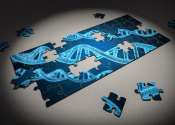International collaboration finds land plant genes in ancient aquatic alga
Land plants, which split from their aquatic relatives 500 million years ago, are an extraordinarily diverse group of living organisms—from tall redwoods to fragrant roses to carpets of moss.









